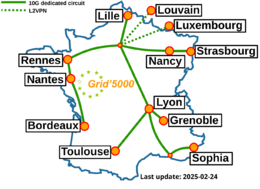Grid5000:Home
|
Grid'5000 is a precursor infrastructure of SLICES-RI, Scientific Large Scale Infrastructure for Computing/Communication Experimental Studies.
|
|
Grid'5000 is a large-scale and flexible testbed for experiment-driven research in all areas of computer science, with a focus on parallel and distributed computing, including Cloud, HPC, Big Data and AI. Key features:
Older documents:
|
Random pick of publications
Five random publications that benefited from Grid'5000 (at least 2927 overall):
- Adrien Berthelot, Eddy Caron, Mathilde Jay, Laurent Lefèvre. Estimating the environmental impact of Generative-AI services using an LCA-based methodology. CIRP LCE 2024 - 31st Conference on Life Cycle Engineering, Jun 2024, Turin, Italy. pp.1-10. hal-04346102v2 view on HAL pdf
- Jolan Philippe, Antoine Omond, Hélène Coullon, Charles Prud'Homme, Issam Raïs. Fast Choreography of Cross-DevOps Reconfiguration with Ballet: A Multi-Site OpenStack Case Study. SANER 2024: IEEE International Conference on Software Analysis, Evolution and Reengineering, Mar 2024, Rovaniemi, Finland. pp.1-11, 10.1109/SANER60148.2024.00007. hal-04457484 view on HAL pdf
- Ismaël Tankeu, Geoffray Bonnin. Towards Characterising Induced Emotions: Exploiting Physiological Data and Investigating the Effect of Music Familiarity. MuRS 2024: 2nd Music Recommender Systems Workshop, Oct 2024, Bari, Italy. hal-04703972 view on HAL pdf
- Jad El Karchi, Hanze Chen, Ali Tehranijamsaz, Ali Jannesari, Mihail Popov, et al.. MPI Errors Detection using GNN Embedding and Vector Embedding over LLVM IR. IPDPS 2024 - 38th International Symposium on Parallel and Distributed Processing, May 2024, San francisco, United States. hal-04724011 view on HAL pdf
- Pierre Epron, Gaël Guibon, Miguel Couceiro. ORPAILLEUR SyNaLP at CLEF 2024 Task 2: Good Old Cross Validation for Large Language Models Yields the Best Humorous Detection. Working Notes of the Conference and Labs of the Evaluation Forum (CLEF 2024), Sep 2024, Grenoble, France. pp.1841-1856. hal-04696012 view on HAL pdf
Latest news
![]() End of support for centOS7/8 and centOSStream8 environments
End of support for centOS7/8 and centOSStream8 environments
Support for the centOS7/8 and centOSStream8 kadeploy environments is stopped due to the end of upstream support and compatibility issues with recent hardware.
The last version of the centOS7 environments (version 2024071117), centOS8 environments (version 2024071119), centOSStream8 environments (version 2024070316) will remain available on /grid5000. Older versions can still be accessed in the archive directory (see /grid5000/README.unmaintained-envs for more information).
-- Grid'5000 Team 08:44, 4 December 2025 (CEST)
![]() Ecotaxe cluster is now in default queue at Nantes
Ecotaxe cluster is now in default queue at Nantes
We are pleased to announce that the ecotaxe cluster of Nantes is now available in the default queue.
As a reminder, ecotaxe is a cluster composed of 2 HPE ProLiant DL385 Gen10 Plus v2 servers[1].
Each node features:
To submit a job on this cluster, the following command may be used:
oarsub -t exotic -p ecotaxe
This cluster is co-funded by Région Pays de la Loire, FEDER and REACT EU via the CPER SAMURAI [3].
[1] https://www.grid5000.fr/w/Nantes:Hardware#ecotaxe
[2] The observed throughput depends on multiple parameters such as the workload, the number of streams, ... [3] https://www.imt-atlantique.fr/fr/recherche-innovation/collaborer/projet/samurai
-- Grid'5000 Team 14:10, 02 December 2025 (CET)
![]() Some changes on the hardware configuration of Grenoble nodes
Some changes on the hardware configuration of Grenoble nodes
We recently did some hardware changes on clusters yeti, troll and dahu.
The changes are as follows:
- yeti-[1,3]: 1× NVMe
- yeti-[2,4]: 2× NVMe
oarsub request. For example:oarsub -I -p "dahu and opa_count > 0"
-- Grid'5000 Team 14:50, 24 November 2025 (CEST)
![]() Cluster "clervaux" is now in the default queue in Luxembourg
Cluster "clervaux" is now in the default queue in Luxembourg
We are pleased to announce that the clervaux[1] cluster of Luxembourg is now available in the default queue.
Clervaux is a cluster composed of 48 CPU nodes.
Each node features:
This cluster was funded by the University of Luxembourg.
[1] https://www.grid5000.fr/w/Luxembourg:Hardware#clervaux
-- Grid'5000 Team 10:50, 21 October 2025 (CEST)
Grid'5000 sites
Current funding
INRIA |
CNRS |
UniversitiesIMT Atlantique |
Regional councilsAquitaine |



